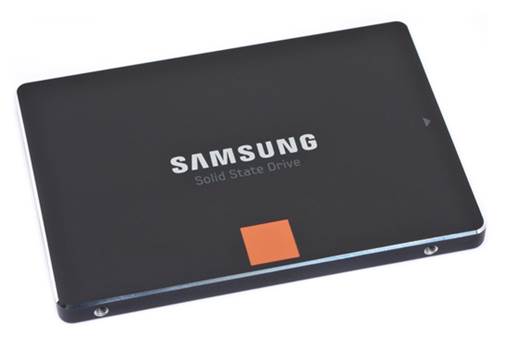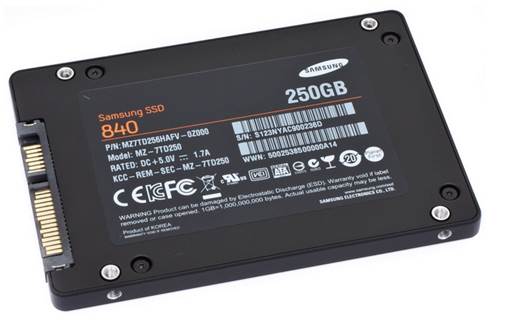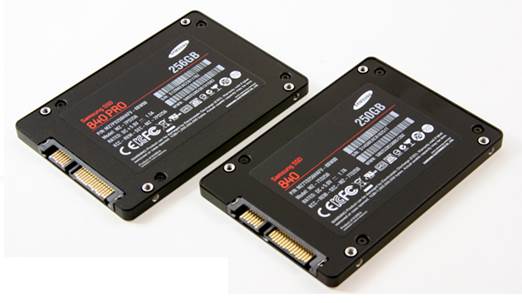Samsung 840 Series 250GB
By now, you've probably heard of the
Samsung 840 Pro - it's the new fat cat in town in the SSD world, and sits atop
our benchmark charts lazily cleaning itself while peering down at all the other
SSDs clamoring to take its place. That drive is redonk, but there's only one
problem - it’s quite expensive at $250. To satiate those who want a Samsung SSD
but don't have two-fiddy lying around, Samsung introduced its midrange drive,
the 840 Amateur (that's what we are calling it). The big deal with this drive
is that it features an all-new kind of NAND known as TLC instead of using the
very common MLC NAND (literally every consumer SSD on the market uses MLC). TLC
stands for triple-level cell as opposed to multilevel cell, as it stores three
bits per cell instead of two. More bits on the same wafer means higher capacities
without increasing cost, but there's a catch - TLC NAND has lower overall
endurance than MLC NAND. but don't get too worked up over it. Though the drive
only has a three-year warranty, as opposed to the five-year warranty of the Pro
version, it's still rated to run for a decade under normal consumer-usage
patterns.

Samsung's
vanilla-flavored 840 SSD is the first to use TLC NAND flash, which helps keep
the price down.
The drive itself features a slim 7mm form
factor in case you want to stuff it inside an Ultrabook, and it rides the SATA
6Gb/s rails. Its bundle includes Samsung's SSD Magician utility, which handles
everything from drive diagnostics to data migration and more, but it lacks a
3.5-inch bay adapter. It’s available in 120GB, 250GB (seen here), and 500GB
versions; the 250GB version we tested is 232GB after formatting.
During testing, the 840 performed
admirably, especially in sequential-read speeds, where it was the fastest drive
in both the tests we use to measure this metric. In Crystal Disk Mark it
saturated the SATA 6Gb/s bus at 523.6MB/s, but its sequential-write speed was
its Achilles' heel at just 260.1MB/s. The OCZ Vertex 4, by comparison, is twice
as fast. Its performance was similar in our four-command-queue test with a 64K
file size, hitting 530.2MB/s read and 265.9MB/s write speeds in ATTO.

The drive deals pretty well with
incompressible data too, taking the top spot in our AS SSD test for 4KB-write
I0PS, but placing mid-pack in 4KB reads. When dealing with a heavy queue of 32
4K write commands, it placed third overall; not too shabby considering it's the
least-expensive drive here.
In our real-world PCMark Vantage test, its
score of 56,482 was again third-best, so it's once again better than average.
Its Premiere Pro 20GB write-test time of 241 ties the OCZ Vertex 4, but all the
drives are very close in this test, suggesting it's CPU-limited.
In our estimation, there's nothing wrong
with the Samsung 840 SSD. It's a low-cost SSD, so you have to consider that
factor when examining the benchmark scores. All the Internet rumors about TLC
NAND being unreliable are just that rumors. Nobody has worn out a TLC NAND
device yet, and it would take quite a long time to ever do so; the same goes
for MLC NAND. so don’t believe the trash talk. Also, we should point out that
Samsung is not an SSD manufacturer that has a reputation for being unreliable.
That said, aside from its excellent sequential-read speeds, there's not much
else to get excited about with this SSD. It's a low-price drive with decent-to-great
performance.

It's
a low-price drive with decent-to-great performance.
|
Samsung 840
Series 250GB
§ Price:
$180
§ Website:
www.samsung.com
§ Type:
Solid State Drive
§ Type:
2.5" 7mm (Ultraslim) Form Factor
§ Type:
840 Series
§ Storage:
Capacity: 250GB
§ Features:
Sequential Read Speed: Up to 530MB/s
§ Features:
Sequential Write Speed: Up to 240MB/s
|